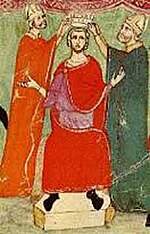Nuova Cronica

A Nuova Cronica ou Novas Crónicas é uma história de Florença escrita, de uma forma linear, seguindo um formato ano por ano, por Giovanni Villani durante o século XIV. A ideia de escrever a Cronica surgiu-lhe depois de estar presente na cerimónia do Jubileu em Roma, onde percebeu que os feitos históricos de Roma eram bem conhecidos, e desejou formular uma história sobre os origens da sua própria cidade, Florença.[2] Na sua Cronica. Villani descreveu em detalhe os muitos projectos de edíficios da sua cidade, informação estatística sobre a população, comércio, trocas, educação e infrastrutura religiosa. Também descreveu muitos desastres tais como as fomes, os incêndios , cheias e a pandemia de Peste Negra, que lhe tirou a vida em 1348.[3][4] O trabalho de Villani foi continuado pelo seu irmão e sobrinho após a sua morte.[2][5][6] Tem sido descrito como a primeira introdução da estatística como elemento positivo na história.[7]
Notas[editar | editar código-fonte]
Referências[editar | editar código-fonte]
- Bartlett, Kenneth R. (1992). The Civilization of the Italian Renaissance. Toronto: D.C. Heath and Company. ISBN 0-669-20900-7 (Paperback).
- Benedictow, Ole Jørgen (2004). The Black Death, 1346-1353: The Complete History. Woodbridge: The Boydell Press. ISBN 0-85115-943-5.
- Caesar, Michael. (1989). Dante, the Critical Heritage, 1314(?)-1870. London: Routledge. ISBN 0-415-02822-1.
- Chisholm, Hugh. (1910). The Encyclopædia Britannica: A Dictionary of Arts, Sciences, Literature. Cambridge: Cambridge University Press.
- De Roover, Raymond. (2007). Money, Banking, and Credit in Medieval Bruges: Italian Merchant-Bankers, Lombards, and Money-Changers, A Study in the Origins of Banking. Cambridge: The Medieval Academy of America.
- De Vries, Kelly. (2006). Infantry Warfare in the Early Fourteenth Century: Discipline, Tactics, and Technology. Woodbridge: The Boydell Press. ISBN 978-0-85115-571-5.
- Elliott, Janis. "The Judgement of the Commune: The Frescoes of the Magdalen Chapel in Florence," Zeitschrift für Kunstgeschichte (61 Bd, H. 4, 1998): 509–519.
- Goldthwaite, Richard A. (1980). The Building of Renaissance Florence: An Economic and Social History. Baltimore: The Johns Hopkins University Press. ISBN 0-8018-2342-0.
- Kleinhenz, Christopher. (2004). Medieval Italy: An Encyclopedia. New York: Routledge. ISBN 0-415-93929-1.
- Lopez, Robert S. and Irving W. Raymond. (2001). Medieval Trade in the Mediterranean World. New York: Columbia University Press. ISBN 0-231-12356-6.
- Miller, Edward (2002). Progress and Problems in Medieval England: Essays in Honour of Edward Miller. Edited by Richard Britnell and John Hatcher. Cambridge: Cambridge University Press. ISBN 0-521-52273-0.
- Olson, Roberta J.M. "An Early Drawing by Luigi Sabatelli Rediscovered," Master Drawings (Volume 35, Number 3, 1997): 289–292.
- Phillips, Mark. "Machiavelli, Guicciardini, and the Tradition of Vernacular Historiography in Florence," The American Historical Review (Volume 84, Number 1, 1979): 86–105.
- Rubinstein, Nicolai. "The Beginnings of Political Thought in Florence. A Study in Mediaeval Historiography," Journal of the Warburg and Courtauld Institutes (Volume 5, 1942): 198–227.
- Rudolph, Julia. (2006). History and Nation. Danvers: Rosemont Printing & Publishing Corp; Cranbury: Associated University Presses. ISBN 978-0-8387-5640-9.
- Spilner, Paula. "Giovanni di Lapo Ghini and a Magnificent New Addition to the Palazzo Vecchio," The Journal of the Society of Architectural Historians (Volume 52, Number 4, 1993): 453–465.
- Vauchez, André, Richard Barrie Dobson and Michael Lapidge. (2000). Encyclopedia of the Middle Ages. Chicago: Fitzroy Dearborn Publishers. ISBN 1-57958-282-6.
- Wicksteed, Philip H. (1906). Villani's Chronicle: Being Selections from the First Nine Books of the Croniche Fiorentine of Giovanni Villani. Translated by Rose E. Selfe. London: Archibald Constable & Co. Ltd.
